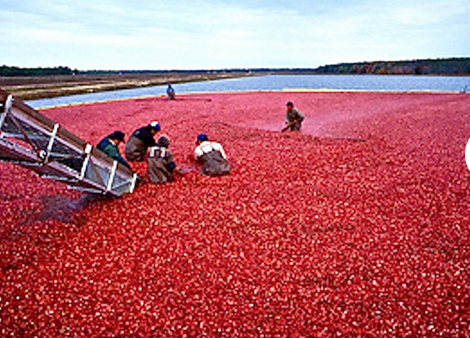By Catharine Kaufman (a.k.a. The Kitchen Shrink)
Cheers to the power of small things! To autumn’s jewel-like cranberries that pack as much super-food punch in their ruby-red spheres as do blueberries and their other Lilliputian relatives that yield their bounty in spring and summer.
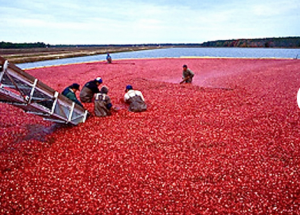 Displays of the tart little berries among the fall produce on supermarket shelves always transport me back to my childhood in Canada, where our family would go cranberry picking in the Muskoka bog* every year. My initiation came when, expecting sweetness the first time I bit into one of the tempting crimson fruit, the mouth-puckering shock made me forget my manners and spat it out.
Displays of the tart little berries among the fall produce on supermarket shelves always transport me back to my childhood in Canada, where our family would go cranberry picking in the Muskoka bog* every year. My initiation came when, expecting sweetness the first time I bit into one of the tempting crimson fruit, the mouth-puckering shock made me forget my manners and spat it out.
Since then, of course, I’ve become enamored of cranberries, which are among the few fruits native to North America and one of the signature foods enriching yet another indigenous fall product of the continent: Thanksgiving. Needless to say, I’m delighted that canning, freezing and other preserving technologies now allow us to enjoy this versatile berry year-round—which I take advantage of by preparing relishes, jellied desserts and condiments whenever the spirit inspires me. A big aficionado of dried cranberries, I knead them into the dough of my baked goods, sprinkle them liberally onto salads and use them to kick up the flavor of soups, stews and other dishes.
(*Thanks to their built-in air pockets, cranberries are bouncy on solid surfaces and float when grown and harvested in water—a method now preferred to cultivating them in bogs and marshes. Not only is harvesting water-grown cranberries easier, but the fruit also benefits from being exposed to more sunlight, which deepens its red color and increases its nutrient content.)
The Mighty Cranberry (a.k.a. Bog Berry) Health Protector
Long before the Pilgrims landed at Plymouth Rock, Native Americans were familiar with the healing and nutritional qualities of cranberries—which they pulped into an antibacterial poultice for the treatment of arrow wounds and other injuries; or mashed and mixed with deer meat to make pemmican, a staple dish that helped tribes survive the long, cold winters.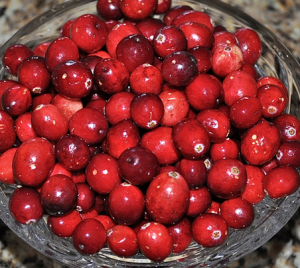
Low in calories but rich in fiber, the cranberry is nature’s protector of the cardiovascular and digestive systems and, thanks to its abundant Vitamin A content, of our eyesight. Its stress-lowering B- vitamins, immune system boosting Vitamin C and its Vitamin K content, which regulates blood viscosity and composition, also distinguish cranberries for their medicinal value. Added to the latter are their considerable store of fortifying minerals, such as manganese, phosphorus and copper; as well as powerful antioxidants—the most popular among them, proanthocyanidins, prevent and, in most cases. help cure urinary tract infections, due to their anti-adhesive properties that keep bacteria from glomming onto urinary tract linings. Most UTIs can be cleared up without antibiotics, by merely drinking a daily shot or two of unsweetened cranberry juice as early as possible from the onset of symptoms, until about 36 hours after they have subsided. Also abundant in cranberries’ arsenal of phytonutrients are anti-inflammatory components, which help protect the mouth and gums, warding off periodontal disease; protect the colon and stomach by preventing ulcers, and the cardiovascular system by lowering blood pressure and keeping “bad” cholesterol in check, while boosting the ratio of ‘good’ cholesterol. Equally important are the results of studies showing that cranberries are effective anti-cancer warriors in the fight against breast, colon, lung and prostate cancers.
Although, unlike pharmaceuticals, cranberries have no known side effects, they do come with a couple of warnings:
- People susceptible to kidney stones should limit their intake to small amounts on rare occasions, since the calcium in their body tends to bind with some elements found in the fruit and form the hard (calcified) clusters which cause that painful condition.
- Like most acidic fruits, cranberry can also pit tooth enamel—a problem easily avoided by rinsing the mouth as soon as possible after consuming it and by using a straw when drinking its juice.
How to Pick Winners
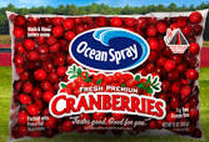 When shopping for cranberries, select firm and smooth (not shriveled), bright scarlet globules, without brown spots or other blemishes. Vacuum-packed cranberries can keep in their original package in the fridge for up to two weeks and in the freezer for one year. But if you buy loose cranberries by the pound, just pinch off any leftover stems and wash the fruit—first in a bowl of cold water with a few squirts of liquid Dr. Bronner’s Castile soap (preferably the ‘Eucalyptus’-infused kind), then rinse the berries thoroughly, also in cold water, until they are soap-free squeaky. Let them drip or pat dry, seal them in zip-lock freezer bags and freeze, so they’ll be ready to use when you are, at a later date or, if you prefer, to prepare them then and there, fresh, crushed raw or cooked.
When shopping for cranberries, select firm and smooth (not shriveled), bright scarlet globules, without brown spots or other blemishes. Vacuum-packed cranberries can keep in their original package in the fridge for up to two weeks and in the freezer for one year. But if you buy loose cranberries by the pound, just pinch off any leftover stems and wash the fruit—first in a bowl of cold water with a few squirts of liquid Dr. Bronner’s Castile soap (preferably the ‘Eucalyptus’-infused kind), then rinse the berries thoroughly, also in cold water, until they are soap-free squeaky. Let them drip or pat dry, seal them in zip-lock freezer bags and freeze, so they’ll be ready to use when you are, at a later date or, if you prefer, to prepare them then and there, fresh, crushed raw or cooked.
Let’s Get Saucy
A traditional holiday table feels naked without cranberry relish, jelly or sauce accompanying the turkey, chicken or even vegan tofu turkey (Tofurky®). So why not expand your cranberry horizons year-round by adding this decorative eye candy, its zip and antioxidant oomph to several courses prepared for any meals? Go crazy. Include fresh or dried cranberries in biscottis, scones, corn breads, cobblers, granola, English Trifle, French Clafoutis, rice pudding and flan. Or use the tart and fruity bits to dial up the flavors of brisket, baked chicken, lamb roasts, stuffings, quinoa and bulgur wheat taboulis, pilafs, green salads, seafood bouillabaisse and grilled or sautéed wild-caught salmon and other fish.
A Cranberry Walks Into a Bar…
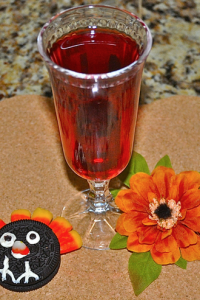 The cocktail crowd could whet their whistle with a Cranberry Vodka Punch, Cran-Martini, Cosmopolitan and Margarita. Meanwhile, eccentric oenophiles may risk their sensitive palates by tasting wines coaxed from this, as well as from a combination of other berries—which can also be served as chilled punch or, fizzed up with club soda for an ersatz bubbly.
The cocktail crowd could whet their whistle with a Cranberry Vodka Punch, Cran-Martini, Cosmopolitan and Margarita. Meanwhile, eccentric oenophiles may risk their sensitive palates by tasting wines coaxed from this, as well as from a combination of other berries—which can also be served as chilled punch or, fizzed up with club soda for an ersatz bubbly.
Cranberry Pedigree
Native Americans called it ibimi, their word for bitter berry, until immigrant German and Dutch settlers renamed it cranberry because of its blossom’s resemblance to the crane bird’s neck and head. Obviously, the more appetizing moniker stuck.
Food historians believe that cranberries were served at the first Thanksgiving feast that brought natives and Pilgrims together in Plymouth. But it seems that the real American love affair with cranberry sauce began in earnest much later, in 1912, when the product was first marketed as a companion to meat and fowl dishes. Today the nation consumes more than 400 million pounds of variously sweetened version of the condiment each year—most of the 20 percent of which is gobbled up in jellied form during Thanksgiving week. In fact, cranberries are now a traditional fare, served at 94 percent of Thanksgiving dinner in the U.S. alone.
(I’ll spare you the Canadian statistics, although since 1957, my native country has been celebrating Thanksgiving on a different date from my adopted one—the second Monday of October—giving me a perfect excuse to prolong the fun and improvise new holiday dishes with which to spoil my family.)
Refreshing Raw Relish Recipe
Since cranberries are composed of nearly 90 percent water, I love to riff on the traditional sauce by preparing a raw, crunchy and refreshing relish that requires no cooking and, what’s more, it can be adapted to a second use by blending appropriate portions with mustard or mayonnaise and adding it as a condiment to leftover turkey sandwiches. Guaranteed to elevate them way above the accustomed (boring?) post-holiday treats.
Gobble, gobble…
1-pound fresh cranberries, washed, stems removed
2 oranges or mandarins, peeled and chopped
½ inch piece of fresh ginger, shredded
½ cup amber honey (adjust to taste)
1-teaspoon (or less) raw (dark brown) sugar
¼ teaspoon cinnamon powder
Zest of one lemon
In a food processor or blender, coarsely chop cranberries and oranges. Transfer to a glass bowl and blend in remaining ingredients. Refrigerate. It will keep well for 2 weeks.
Portions used as sandwich condiment should be used when prepared.
(For additional cranberry or other recipes, email us at [email protected], or to The Kitchen Shrink directly at [email protected] .)

